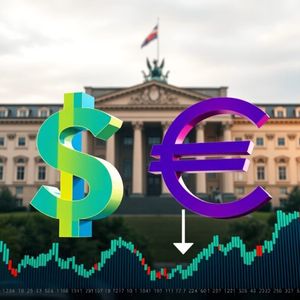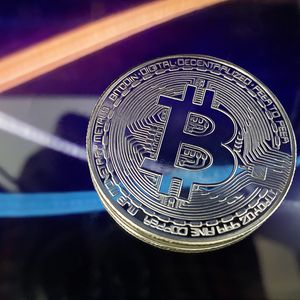BitcoinWorld Swedish Rate Cut Looms: UBS Predicts Pivotal September Shift for Riksbank and EUR/SEK In the dynamic world of global finance, macroeconomic shifts often ripple through various asset classes, including the often-volatile cryptocurrency market. While your focus might primarily be on Bitcoin or Ethereum, understanding central bank decisions, like an impending Swedish rate cut , can offer crucial insights into broader market liquidity and investor sentiment. A significant forecast from UBS suggests that Sweden’s central bank, the Riksbank, is poised to implement a key interest rate reduction as early as September. This move, if it materializes, carries substantial implications not just for the Nordic economy but also for currency traders monitoring the EUR/SEK pair and, by extension, the global financial landscape that influences crypto flows. Why is a Swedish Rate Cut Expected So Soon? The anticipation of a Swedish rate cut in September by UBS stems from a careful analysis of the country’s economic indicators and the Riksbank’s evolving stance on inflation. Sweden, like many other nations, has grappled with elevated inflation in recent years, prompting aggressive monetary tightening. However, recent data points suggest a shift in this narrative, creating an environment ripe for policy adjustments. Declining Inflation: Sweden’s inflation rate has shown a consistent downward trend, moving closer to the Riksbank’s 2% target. This disinflationary pressure provides the central bank with more flexibility to consider easing its monetary policy. Economic Slowdown: The Swedish economy has exhibited signs of slowing growth, with consumer spending and industrial production facing headwinds. A rate cut could provide a much-needed stimulus to boost economic activity and prevent a deeper recession. Global Central Bank Peers: While not directly dictating policy, the actions of other major central banks, particularly the European Central Bank (ECB), often influence the Riksbank. If the ECB begins to cut rates, it could put pressure on the Riksbank to follow suit to maintain competitiveness and avoid undue currency appreciation. Weakening Housing Market: Sweden’s housing market has experienced a significant downturn, partly due to higher interest rates. A rate cut could offer some relief to mortgage holders and stabilize the real estate sector. UBS’s projection is not made in isolation; it reflects a growing consensus among analysts who observe the delicate balance the Riksbank must strike between controlling inflation and supporting economic growth. The September timeline suggests that UBS believes the incoming data will sufficiently cement the case for easing by then. Understanding the Riksbank’s Monetary Policy Trajectory and Riksbank Interest Rates The Riksbank, Sweden’s central bank, has historically been known for its pragmatic approach to monetary policy. Its primary mandate is to maintain price stability, typically defined as an inflation target of 2%. Over the past few years, the Riksbank has been on an aggressive tightening path, raising Riksbank interest rates significantly to combat stubbornly high inflation. This period saw the policy rate climb from negative territory to levels not seen in over a decade. However, as inflation cools, the focus shifts. The Riksbank’s communications have become increasingly nuanced, acknowledging both the progress made on inflation and the risks of overtightening. Their trajectory now appears to be moving towards a more accommodative stance, though the timing and magnitude of any cuts remain subject to incoming economic data. The bank often emphasizes a ‘data-dependent’ approach, meaning each policy decision is heavily influenced by the latest inflation figures, unemployment rates, and GDP growth. Compared to its major counterparts, the Riksbank often finds itself navigating unique domestic pressures while also considering global economic trends. Here’s a simplified comparison of recent rate movements (illustrative): Central Bank Recent Policy Stance Inflation Outlook Riksbank (Sweden) Aggressive hikes, now signaling potential cuts as inflation cools. Moving towards 2% target, but core inflation watched closely. ECB (Eurozone) Hikes have peaked, discussions on potential cuts in mid-2024. Disinflation underway, but services inflation remains sticky. Federal Reserve (US) Hikes have likely peaked, market expects cuts later in 2024. Inflation easing, but labor market strength provides resilience. The challenge for the Riksbank lies in timing its cuts perfectly – cutting too early could reignite inflation, while cutting too late could stifle economic recovery. This delicate balancing act forms the core of their ongoing monetary policy discussions. What Does This Mean for the EUR/SEK Forecast? The prospect of a Swedish rate cut has significant implications for the EUR/SEK currency pair. In the world of foreign exchange, interest rate differentials are a primary driver of currency valuations. Generally, a country with higher interest rates tends to attract capital, strengthening its currency, while lower rates can lead to capital outflow and currency depreciation. If the Riksbank cuts rates in September, and especially if the European Central Bank (ECB) holds steady or cuts later, the interest rate differential between Sweden and the Eurozone could narrow. This scenario would typically make the Swedish Krona (SEK) less attractive to yield-seeking investors, potentially leading to a weakening of the SEK against the Euro (EUR). Conversely, if the ECB were to cut rates aggressively before or alongside the Riksbank, the impact on EUR/SEK might be less pronounced, or even reverse, depending on the relative magnitudes of the cuts. UBS’s commentary on EUR/SEK would likely reflect this dynamic. A rate cut would imply a higher EUR/SEK, meaning it would take more SEK to buy one Euro. Traders and investors closely watch these forecasts to position themselves in the currency market. For instance: Scenario 1 (Riksbank cuts, ECB holds): Expect EUR/SEK to rise, as the SEK weakens relative to the EUR. Scenario 2 (Riksbank and ECB both cut): The movement in EUR/SEK would depend on which central bank cuts more aggressively or has a more dovish forward guidance. Scenario 3 (Riksbank delays, ECB cuts): This would likely see EUR/SEK fall, as the SEK becomes relatively more attractive. The EUR/SEK forecast is therefore not just about the Riksbank’s actions but also about the relative performance and policy of the ECB. Market participants will be keenly observing both central banks’ communications for clues. UBS’s Broader Economic Outlook: Beyond Sweden UBS, as a global financial powerhouse, provides an extensive UBS economic outlook that extends far beyond the borders of Sweden. Their analysis of the Swedish rate cut in September is often contextualized within their broader view of global economic trends, inflation trajectories, and the future path of major central banks like the Federal Reserve, ECB, and Bank of England. This holistic perspective is crucial for understanding the interconnectedness of financial markets. For example, UBS might view the Swedish situation as a microcosm of a wider trend where advanced economies are transitioning from an era of aggressive monetary tightening to one of cautious easing. They might highlight: Global Disinflation: A general trend of falling inflation across many developed economies, driven by supply chain normalization and demand cooling. Economic Soft Landing: Hopes that major economies can avoid a deep recession, achieving a ‘soft landing’ where inflation is tamed without severe economic contraction. Divergent Central Bank Paths: While many central banks may eventually cut rates, the timing and speed could differ significantly based on unique domestic conditions. This broader outlook informs their specific predictions, like the one for Sweden. For investors, understanding UBS’s macro view can offer actionable insights. If UBS believes a global easing cycle is beginning, it might signal a shift in investment strategies, potentially favoring riskier assets, including cryptocurrencies, as liquidity increases and borrowing costs decrease. Conversely, if their outlook points to continued uncertainty or stagflation, defensive positions might be preferred. Navigating Monetary Policy Sweden: Challenges and Opportunities The Riksbank’s upcoming decisions on Monetary policy Sweden present both significant challenges and unique opportunities for market participants. For the central bank itself, the primary challenge is to manage expectations and communicate its intentions clearly to avoid market volatility. It must ensure that any rate cut is perceived as a measured response to economic conditions rather than a panicked reaction. Challenges for the Riksbank: Inflation Resurgence Risk: Cutting rates too soon could risk reigniting inflation, undoing the hard-won progress. Exchange Rate Volatility: A rate cut could weaken the SEK, making imports more expensive and potentially contributing to inflation. Balancing Growth vs. Stability: The delicate act of stimulating a slowing economy without compromising price stability. Opportunities for Investors: Currency Trading: For forex traders, the anticipated rate cut creates clear directional biases for EUR/SEK and other SEK pairs. Strategic positioning based on UBS’s forecast could yield profits. Bond Market: A rate cut typically leads to lower bond yields. Investors in Swedish government bonds or corporate bonds might see capital gains on existing holdings or find opportunities in re-evaluating their fixed-income portfolios. Equity Market: Lower interest rates can reduce borrowing costs for companies, potentially boosting corporate earnings and making equities more attractive. Sectors sensitive to interest rates, like real estate or utilities, could see particular benefits. Global Market Impact: The Riksbank’s move, as part of a potential global easing trend, could contribute to a broader environment of increased liquidity, which historically has been supportive of risk assets, including cryptocurrencies. Understanding the nuances of Monetary policy Sweden is not just for specialists. These decisions cascade through the financial system, influencing everything from the cost of borrowing for a Swedish homeowner to the speculative appeal of a global asset like Bitcoin. Staying informed allows investors to anticipate these shifts and adjust their strategies accordingly. A Pivotal Moment for Sweden’s Economy UBS’s forecast of a Swedish rate cut in September signals a pivotal moment for the Riksbank and the broader Swedish economy. As inflation recedes, the central bank is likely to pivot from its aggressive tightening stance towards easing, a move that could significantly impact Riksbank interest rates and the valuation of the EUR/SEK forecast . This shift, embedded within UBS’s comprehensive UBS economic outlook , underscores the evolving landscape of global Monetary policy Sweden . While challenges remain, particularly regarding the delicate balance between stimulating growth and maintaining price stability, the anticipated rate cut presents clear opportunities for astute investors across various markets, from forex to equities and even potentially influencing the broader liquidity environment that impacts digital assets. Keeping a close watch on the Riksbank’s communications and incoming economic data will be essential for navigating these financial waters successfully. To learn more about the latest Forex market trends, explore our article on key developments shaping interest rates and currency movements. This post Swedish Rate Cut Looms: UBS Predicts Pivotal September Shift for Riksbank and EUR/SEK first appeared on BitcoinWorld and is written by Editorial Team
















